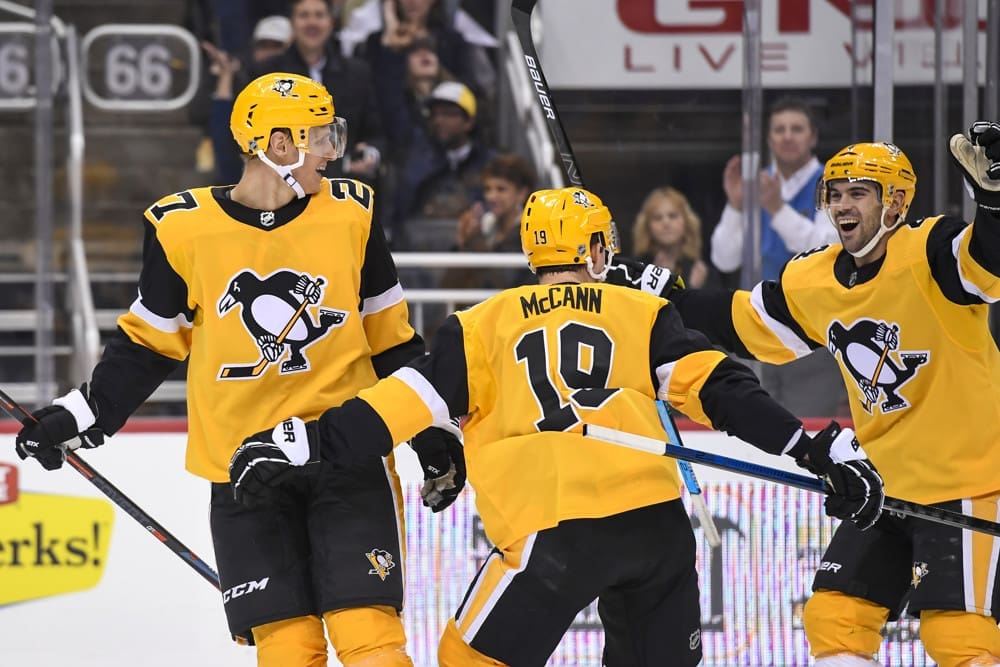Penguins
Penguins Trade Aftermath; What the Bjugstad Trade Means

Pittsburgh Penguins GM Jim Rutherford found a willing partner for the second Penguins trade of the offseason, and now the Penguins have just a little bit of salary cap wiggle room.
Just a little bit.
Rutherford went the trade route, but the move wasn’t without question. The Penguins dealt Nick Bjugstad to the Minnesota Wild and held back 50% of Bjugstad’s salary ($2.05 million), which means the Penguins both saved $2.05 million this season and have $2.05 million in dead money.
In layman’s terms, the Penguins have an extra $2 million to spend but will hit an on-ice salary ceiling of $79.5 million, which is two million less than the salary cap.
The Penguins’ alternative with Bjugstad was a buyout. According to CapFriendly.com, a buyout would have afforded the Penguins an extra $3.5 million in salary-cap space this season, in exchange for $1.75 million in dead money next season.
It’s highly likely that by next season both Sam Poulin and P-O Joseph will be in the Penguins lineup and on entry-level deals, which cost less than $1 million.
Rutherford chose the trade path and to take a larger hit, but to get it over.
First, the Penguins trade does increase the probability that Patric Hornqvist can and will remain with the Pittsburgh Penguins.
Now, the Penguins have about $8.9 million to spend on RFAs Tristan Jarry, Jared McCann, Dominik Simon, Sam Lafferty, and others. The first three have arbitration rights, so the Penguins aren’t in total control of the salary process.
HN has estimated, based on recent cases and contracts, Jared McCann’s value to be close to $3 million. We view Tristan Jarry in the same range, though probably a touch more expensive as an All-Star starting goalie.
For round numbers, let us assume the Penguins will spend about $6.5 million for Jarry and McCann, which leaves them with $2.4 million. Let’s put $800,000 in the piggy bank, so the Penguins have an emergency cushion in case the exterminators didn’t kill the injury bugs hiding at PPG Paints Arena.
So, the Penguins are playing with about $1.6 million. It will be tight, but that should be enough to sign Simon and Lafferty, give or take a couple hundred thousand.
Without Bjugstad, the situation will likely force head coach Mike Sullivan to keep McCann at center. It’s not ideal for the player or team, but the sacrifice has been the name of the game since the pandemic pause.
Penguins winger Zach Aston-Reese will also begin the season on LTIR, assuming the season begins on time in December. The Penguins technically have a few extra dollars while Aston-Reese recuperates. Simon also had surgery in late April and will not be ready until December or January.
The Penguins must decide if they’ll give Simon a Qualifying Offer. He’s arbitration-eligible, which is bad news, but the QO would only be $825,000, which is the good news. If Simon rejects his qualifier, the Penguins could move on and repurpose that money, too.
However, unless the Penguins and Simon part, the team will appear to have a few more dollars than they actually do because Aston-Reese and presumably Simon will be moved to LTIR. Because both players will be ready early in the season, or at the start of the season, the Penguins can’t really spend the cash which will appear to be available.
There are likely more trades coming, beyond the Penguins trade of Matt Murray, but for now, the Penguins lines look like this:
Guentzel-Crosby-Kapanen
Zucker-Malkin-Rust
Simon/Lafferty-McCann-Hornqvist
Aston-Reese–Blueger–Tanev
Of course, Poulin could elbow his way into the Penguins lineup. Surely the Penguins and Rutherford are hopeful Poulin is ready. Unfortunately, secondary exposure to COVID-19 cost Poulin most of the July training camp, but Poulin did play in two scrimmages. He didn’t dominate, but he showed well enough that PHN dished a good grade for his second performance.
Poulin’s salary would be about $894k, so the Penguins could also bank on Poulin’s arrival and cut ties with Simon, too. Anthony Angello and Thomas Di Pauli filled in well enough at the NHL level this season; they could be counted on for depth positions.
Rutherford’s deal may not have saved the Penguins the most money possible, but it did add a bit of breathing room. Perhaps just enough.











